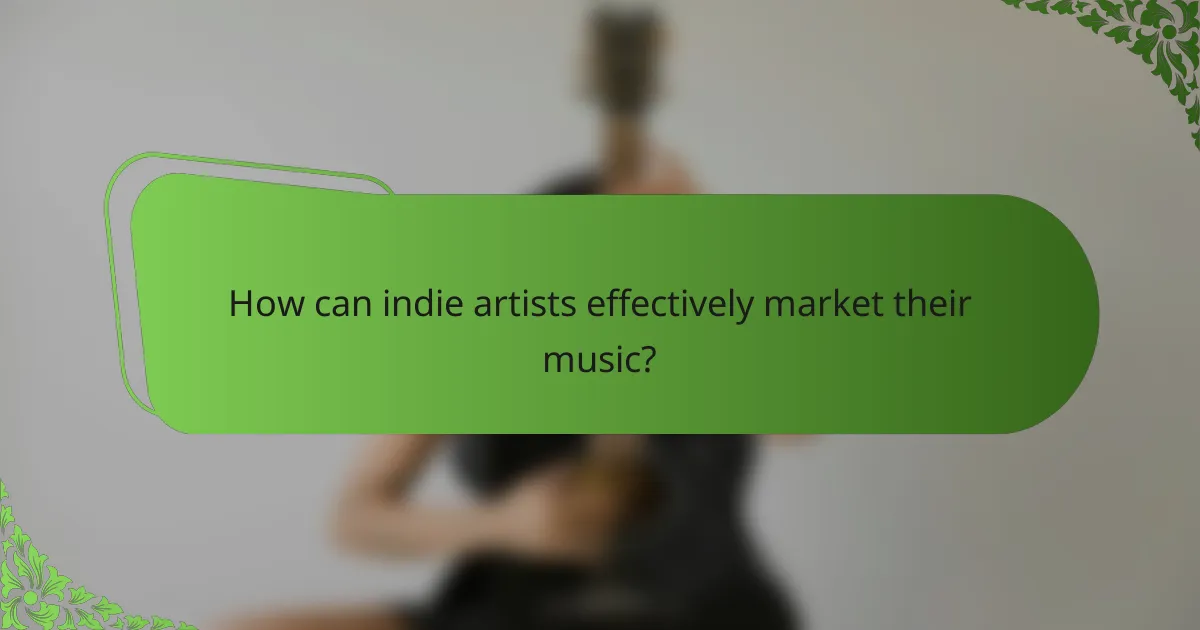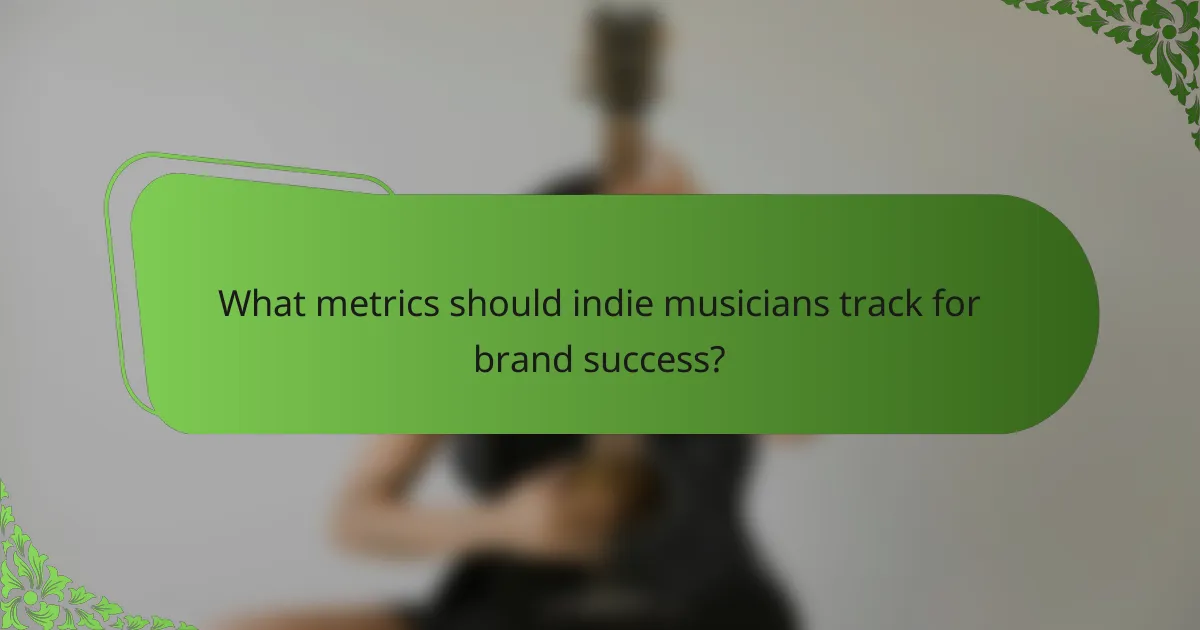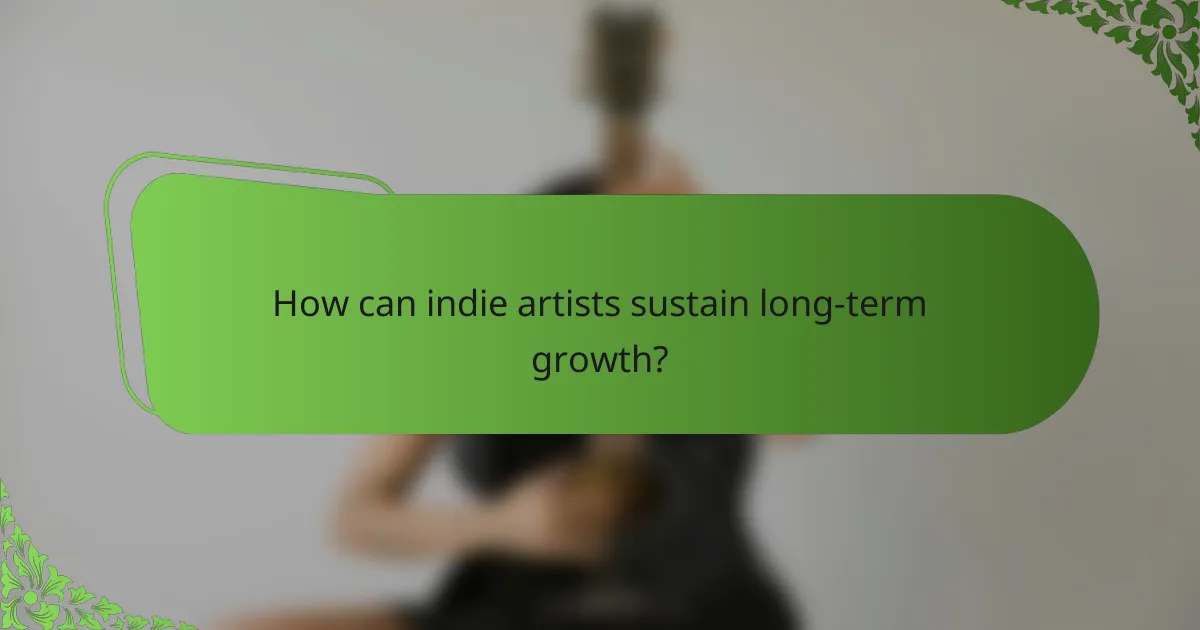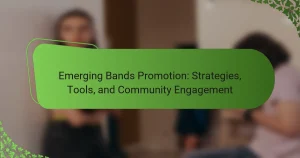Building a successful indie music brand involves overcoming challenges like market saturation and financial constraints. Establish a strong brand identity, utilise effective marketing strategies, and engage with your audience. Collaborate with other artists to expand your reach and track key metrics to ensure growth. Consistency in branding and quality content are essential for long-term success in the competitive music industry.

What are the key elements of an indie music brand identity?
An indie music brand identity revolves around authenticity, unique sound, and visual aesthetics. Key elements include a distinct musical style, relatable messaging, and a cohesive visual presence. Engaging storytelling connects with the audience, while social media strategies enhance visibility. Collaborations with like-minded artists can further strengthen identity.
How does visual branding influence audience perception?
Visual branding significantly shapes audience perception by creating a distinct identity that resonates emotionally. A cohesive visual identity, including logos, colour schemes, and typography, fosters recognition and trust. For indie music brands, strong visuals can differentiate them in a crowded market, enhancing engagement and loyalty. Effective visual branding communicates the brand’s values and story, influencing how audiences connect with the music and the artist.
What role does storytelling play in building brand identity?
Storytelling is essential for building brand identity in indie music. It creates emotional connections, enhances relatability, and differentiates the brand. Engaging narratives can convey the artist’s journey, values, and unique style. This fosters loyalty among fans and encourages organic growth. By integrating personal stories, indie brands can effectively communicate their essence and resonate with target audiences.
Which values resonate most with indie music audiences?
Indie music audiences resonate most with authenticity, community connection, and artistic freedom. These values create a strong bond between artists and fans. Authenticity fosters trust, while community connection encourages shared experiences. Artistic freedom allows for diverse expressions, appealing to listeners seeking originality.

How can indie artists effectively market their music?
Indie artists can effectively market their music by establishing a strong brand identity, utilising social media, and engaging with their audience. Building a unique image helps differentiate them in a crowded market. Consistent content across platforms fosters recognition and loyalty. Collaborating with other artists expands reach and introduces new fans. Regularly analysing engagement metrics allows artists to refine their strategies for better results.
What are the most effective digital marketing strategies for indie musicians?
To effectively market indie musicians, focus on building a strong brand identity, leveraging social media, and engaging with audiences.
Establish a unique artistic identity that resonates with fans. Utilise platforms like Instagram, TikTok, and YouTube to showcase music and behind-the-scenes content. Regularly interact with followers to foster community and loyalty.
Invest in email marketing to maintain direct communication with fans, sharing updates and exclusive content. Collaborate with other artists to expand reach and tap into new audiences.
Utilise data analytics to track engagement and refine strategies. Experiment with different content types to see what resonates best, adjusting tactics based on audience feedback and preferences.
How does social media engagement impact brand growth?
Social media engagement significantly boosts brand growth by enhancing visibility and fostering community. Active interaction with followers cultivates loyalty and trust, which are essential for indie music brands. Engaged audiences are more likely to share content, leading to organic reach and increased fan base. Additionally, analytics from social media platforms provide insights into audience preferences, enabling tailored marketing strategies. These strategies can include targeted promotions and collaborations, ultimately driving sales and brand recognition.
Which platforms are crucial for indie music promotion?
Social media platforms, streaming services, and music blogs are crucial for indie music promotion.
Platforms like Instagram and TikTok allow artists to engage directly with fans and showcase their music visually. Spotify and Apple Music provide essential streaming opportunities, enabling wider audience reach. Additionally, music blogs and online magazines can amplify visibility through reviews and features, enhancing credibility and attracting new listeners.

What challenges do indie artists face in brand building?
Indie artists face several challenges in brand building, including limited resources, market saturation, and audience engagement. These obstacles hinder their ability to establish a unique identity and reach potential fans effectively.
One significant challenge is the lack of financial support. Indie artists often operate on tight budgets, limiting their marketing efforts and promotional activities. As a result, they struggle to create professional-quality content that can compete with mainstream artists.
Market saturation presents another hurdle. The music industry is crowded with numerous indie artists vying for attention. This makes it difficult for individual artists to stand out and gain recognition in a sea of competition.
Audience engagement is also a critical issue. Many indie artists find it challenging to connect with their target audience consistently. Building a loyal fan base requires ongoing interaction and relationship management, which can be time-consuming and demanding.
In summary, indie artists must navigate financial constraints, market saturation, and audience engagement challenges to build a successful music brand.
How can budget constraints affect marketing efforts?
Budget constraints can significantly limit marketing efforts for an indie music brand. They can restrict options for promotional platforms, reduce the scope of campaigns, and hinder the ability to reach target audiences effectively.
Limited budgets often necessitate prioritising low-cost strategies, such as leveraging social media and organic content, rather than investing in expensive advertising. As a result, indie artists may miss opportunities for broader exposure and audience engagement.
Additionally, budget constraints can impact the quality of marketing materials, leading to less professional branding. This can affect how potential fans perceive the artist, ultimately influencing growth and identity in the competitive music industry.
What are common pitfalls in the indie music branding process?
Common pitfalls in the indie music branding process include neglecting audience engagement, inconsistent messaging, and inadequate online presence. These issues can hinder growth and recognition.
Failing to connect with fans can result in a lack of loyalty. Inconsistent branding across platforms may confuse potential listeners. Additionally, not utilising social media effectively can limit exposure to new audiences.
Ignoring market trends can also be detrimental. Indie artists should stay informed about changes in music consumption and adapt their strategies accordingly.
Lastly, underestimating the importance of professional visuals, such as album artwork and promotional materials, can weaken a brand’s identity. High-quality visuals create a memorable impression and enhance credibility.

How can collaborations enhance an indie music brand?
Collaborations can significantly enhance an indie music brand by expanding its reach and audience. Partnering with other artists or brands creates cross-promotion opportunities, exposing each party to new fan bases. Collaborations can also lead to unique content, such as joint tracks or performances, which can attract media attention and increase engagement. Additionally, leveraging the strengths of collaborators can enhance credibility and authenticity, vital attributes for indie brands. Engaging in collaborations can also foster a sense of community, which can be a unique attribute that resonates with audiences seeking connection.
Which types of partnerships are most beneficial for growth?
Collaborative partnerships, strategic alliances, and sponsorships are most beneficial for growth in the indie music brand. Collaborative partnerships with other artists can expand reach and audience engagement. Strategic alliances with brands or influencers enhance visibility and credibility. Sponsorships provide financial support and resources for marketing and production. Each type of partnership can leverage unique attributes, such as shared audiences or complementary skills, driving mutual growth.
How do collaborations with other artists affect audience reach?
Collaborations with other artists significantly enhance audience reach. By combining fan bases, artists expose themselves to new listeners and increase their visibility. Collaborations can also improve credibility, as established artists lend their reputation to emerging talents. Additionally, joint promotional efforts often lead to increased engagement on social media platforms, further amplifying reach. Unique collaborations can create buzz, resulting in higher streaming numbers and concert attendance.

What metrics should indie musicians track for brand success?
Indie musicians should track metrics such as engagement rates, streaming numbers, social media growth, email list sign-ups, and merchandise sales for brand success. These metrics provide insights into audience connection and market performance.
| Metric | Description | Importance |
|————————-|———————————————|———————————————-|
| Engagement Rates | Likes, shares, comments on social media | Indicates audience interaction and interest |
| Streaming Numbers | Plays on platforms like Spotify or Apple | Reflects popularity and reach |
| Social Media Growth | Followers and interactions over time | Shows brand visibility and audience expansion |
| Email List Sign-Ups | Number of subscribers to newsletters | Indicates direct audience engagement |
| Merchandise Sales | Revenue from sold products | Reflects financial success and brand loyalty |
How can streaming data inform marketing strategies?
Streaming data enhances marketing strategies by providing real-time insights into audience behaviour and preferences. This allows indie music brands to tailor their messaging and engagement efforts effectively. By analysing streaming metrics, such as listener demographics and song popularity, brands can identify trends and optimise promotional campaigns. Additionally, leveraging data from platforms like Spotify can inform decisions on tour locations and merchandise offerings, ultimately fostering brand growth.
What role does fan engagement play in measuring brand growth?
Fan engagement is crucial for measuring brand growth as it directly reflects audience loyalty and market reach. Engaged fans contribute to word-of-mouth promotion and social media visibility. Metrics like social media interactions, streaming numbers, and concert attendance provide quantifiable data on engagement levels. These indicators help indie music brands refine marketing strategies and identify growth opportunities, enhancing their overall identity in the market.

How can indie artists sustain long-term growth?
Indie artists can sustain long-term growth by building a strong brand identity and implementing effective marketing strategies. Consistency in branding fosters recognition and loyalty among fans. Engaging with audiences through social media and live performances enhances connection and community. Investing in quality music production and visual content elevates the overall brand perception. Collaborating with other artists and brands can expand reach and introduce new audiences. Regularly analysing metrics and adapting strategies ensures relevance in a changing industry.
What strategies foster community building around an indie music brand?
Engaging strategies for community building around an indie music brand include fostering authentic connections, creating immersive experiences, and leveraging social media. Authentic connections arise from genuine interactions with fans, encouraging dialogue and feedback. Immersive experiences, such as live events and exclusive content, deepen fan loyalty and engagement. Social media platforms serve as vital tools for sharing updates, promoting collaborations, and highlighting community stories, enhancing brand visibility. These strategies collectively contribute to a strong, supportive community that drives brand growth.
How do evolving music trends impact brand evolution?
Evolving music trends significantly influence brand evolution by shaping identity, marketing strategies, and growth opportunities. Brands that adapt to trends can enhance relevance and connect with audiences. For instance, the rise of streaming services has shifted marketing strategies towards digital engagement and social media presence. Additionally, collaboration with emerging artists can provide unique brand positioning, appealing to niche markets. As a result, brands that embrace these trends often experience accelerated growth and increased loyalty from their target audience.
What are best practices for maintaining brand relevance?
To maintain brand relevance, indie music brands should consistently engage with their audience, adapt to trends, and uphold their unique identity. Regularly updating content across platforms fosters connection and showcases authenticity. Collaborating with other artists can expand reach and introduce fresh perspectives. Monitoring audience feedback and analytics helps in refining strategies, ensuring alignment with listener preferences. Emphasising storytelling in marketing strengthens emotional ties, making the brand memorable.
What common mistakes should indie artists avoid in brand building?
Indie artists should avoid common mistakes like neglecting their unique identity, failing to engage with their audience, and overlooking consistent branding. Establishing a strong visual and auditory identity is crucial for differentiation. Engaging with fans through authentic interactions fosters loyalty. Consistency across platforms in messaging and visuals reinforces brand recognition.


